length TOYOTA PROACE 2023 Owners Manual
[x] Cancel search | Manufacturer: TOYOTA, Model Year: 2023, Model line: PROACE, Model: TOYOTA PROACE 2023Pages: 360, PDF Size: 70.22 MB
Page 68 of 360

68
Moving forward or backward
(example for an individual seat)
Two controls are provided for moving the seat forward and backward:► From the rear, pull the strap without going beyond the point of resistance and push the seat forward or pull it backward.► From the front, raise the control and slide the seat forward or backward.
Moving the seat along the
full length of the rail
► Slide the seat by pulling on the front control or rear strap.
Folding the backrest to the
table position
(example for an individual seat)► Put the head restraints in the low position.
► From the rear, lower the handle to release the backrest.► From the front, raise the handle to release the backrest.► Fold the backrest onto the cushion.
WARNI NG
Do not leave objects (such as a bag or toys) on the cushion when folding the backrest.
Removing
(example of an individual seat)► Move the seat forward for access to the strap.► Fold the backrest to the table position
► From the rear, pull the strap fully to release the anchorages and tip the seat forwards to place it in the vertical position.► Remove the seat through the side door for row 2 or through the rear for row 3.
Refitting
Page 116 of 360
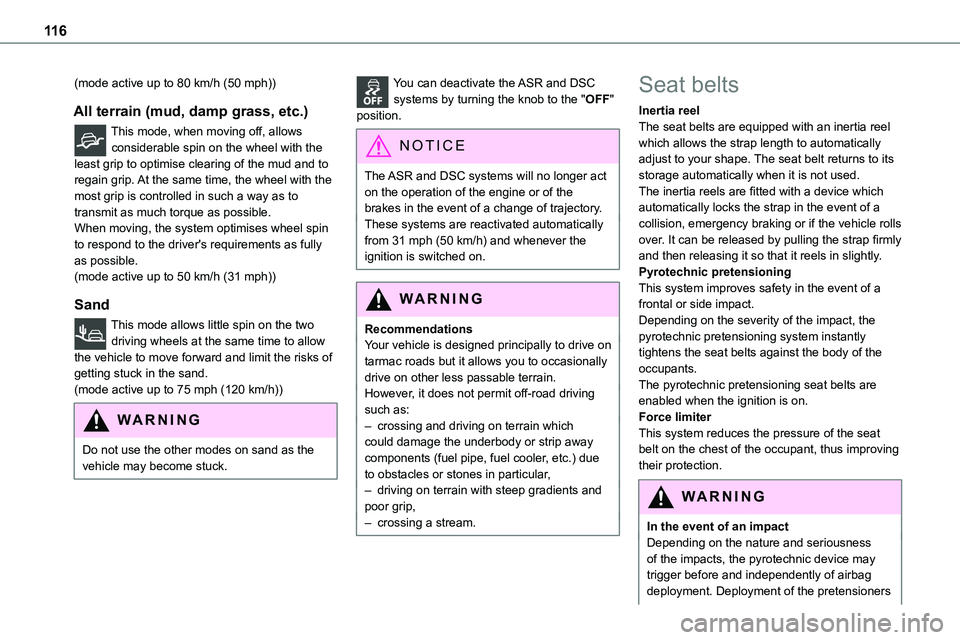
11 6
(mode active up to 80 km/h (50 mph))
All terrain (mud, damp grass, etc.)
This mode, when moving off, allows considerable spin on the wheel with the least grip to optimise clearing of the mud and to regain grip. At the same time, the wheel with the most grip is controlled in such a way as to transmit as much torque as possible.
When moving, the system optimises wheel spin to respond to the driver's requirements as fully as possible.(mode active up to 50 km/h (31 mph))
Sand
This mode allows little spin on the two driving wheels at the same time to allow the vehicle to move forward and limit the risks of getting stuck in the sand.(mode active up to 75 mph (120 km/h))
WARNI NG
Do not use the other modes on sand as the vehicle may become stuck.
You can deactivate the ASR and DSC systems by turning the knob to the "OFF" position.
NOTIC E
The ASR and DSC systems will no longer act on the operation of the engine or of the brakes in the event of a change of trajectory.These systems are reactivated automatically from 31 mph (50 km/h) and whenever the ignition is switched on.
WARNI NG
RecommendationsYour vehicle is designed principally to drive on tarmac roads but it allows you to occasionally drive on other less passable terrain.However, it does not permit off-road driving such as:– crossing and driving on terrain which could damage the underbody or strip away components (fuel pipe, fuel cooler, etc.) due to obstacles or stones in particular,– driving on terrain with steep gradients and poor grip,– crossing a stream.
Seat belts
Inertia reelThe seat belts are equipped with an inertia reel which allows the strap length to automatically adjust to your shape. The seat belt returns to its storage automatically when it is not used.The inertia reels are fitted with a device which automatically locks the strap in the event of a
collision, emergency braking or if the vehicle rolls over. It can be released by pulling the strap firmly and then releasing it so that it reels in slightly.Pyrotechnic pretensioningThis system improves safety in the event of a frontal or side impact.Depending on the severity of the impact, the pyrotechnic pretensioning system instantly tightens the seat belts against the body of the occupants.The pyrotechnic pretensioning seat belts are enabled when the ignition is on.Force limiterThis system reduces the pressure of the seat belt on the chest of the occupant, thus improving their protection.
WARNI NG
In the event of an impactDepending on the nature and seriousness of the impacts, the pyrotechnic device may trigger before and independently of airbag deployment. Deployment of the pretensioners
Page 168 of 360
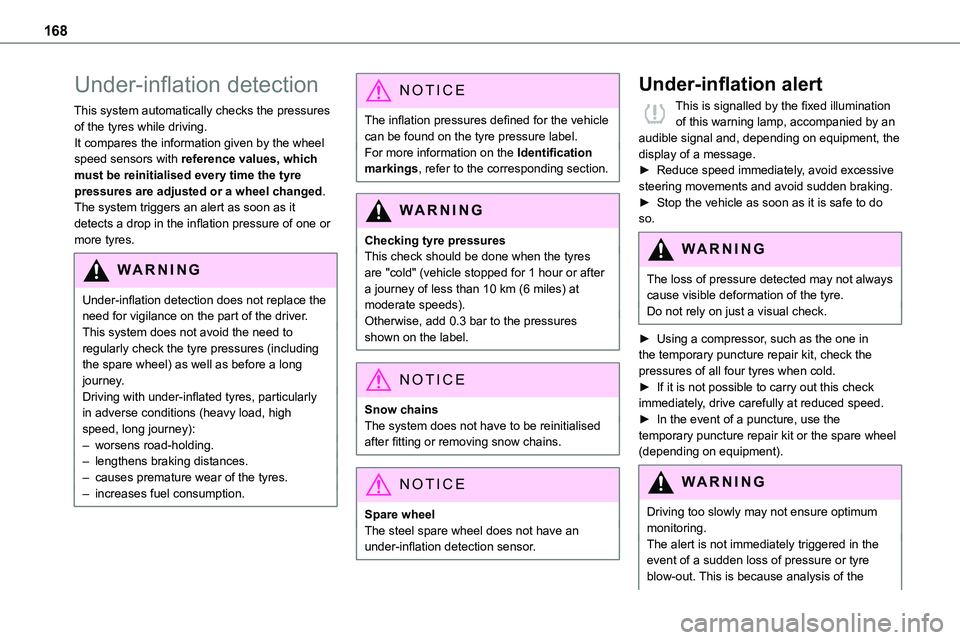
168
Under-inflation detection
This system automatically checks the pressures of the tyres while driving.It compares the information given by the wheel speed sensors with reference values, which must be reinitialised every time the tyre pressures are adjusted or a wheel changed.The system triggers an alert as soon as it
detects a drop in the inflation pressure of one or more tyres.
WARNI NG
Under-inflation detection does not replace the need for vigilance on the part of the driver.This system does not avoid the need to regularly check the tyre pressures (including the spare wheel) as well as before a long journey.Driving with under-inflated tyres, particularly in adverse conditions (heavy load, high speed, long journey):– worsens road-holding.– lengthens braking distances.– causes premature wear of the tyres.– increases fuel consumption.
NOTIC E
The inflation pressures defined for the vehicle can be found on the tyre pressure label.For more information on the Identification markings, refer to the corresponding section.
WARNI NG
Checking tyre pressuresThis check should be done when the tyres are "cold" (vehicle stopped for 1 hour or after a journey of less than 10 km (6 miles) at moderate speeds).Otherwise, add 0.3 bar to the pressures shown on the label.
NOTIC E
Snow chainsThe system does not have to be reinitialised after fitting or removing snow chains.
NOTIC E
Spare wheelThe steel spare wheel does not have an
under-inflation detection sensor.
Under-inflation alert
This is signalled by the fixed illumination of this warning lamp, accompanied by an audible signal and, depending on equipment, the display of a message.► Reduce speed immediately, avoid excessive steering movements and avoid sudden braking.► Stop the vehicle as soon as it is safe to do so.
WARNI NG
The loss of pressure detected may not always cause visible deformation of the tyre.Do not rely on just a visual check.
► Using a compressor, such as the one in the temporary puncture repair kit, check the pressures of all four tyres when cold.► If it is not possible to carry out this check immediately, drive carefully at reduced speed.► In the event of a puncture, use the temporary puncture repair kit or the spare wheel (depending on equipment).
WARNI NG
Driving too slowly may not ensure optimum monitoring.The alert is not immediately triggered in the event of a sudden loss of pressure or tyre blow-out. This is because analysis of the
Page 205 of 360
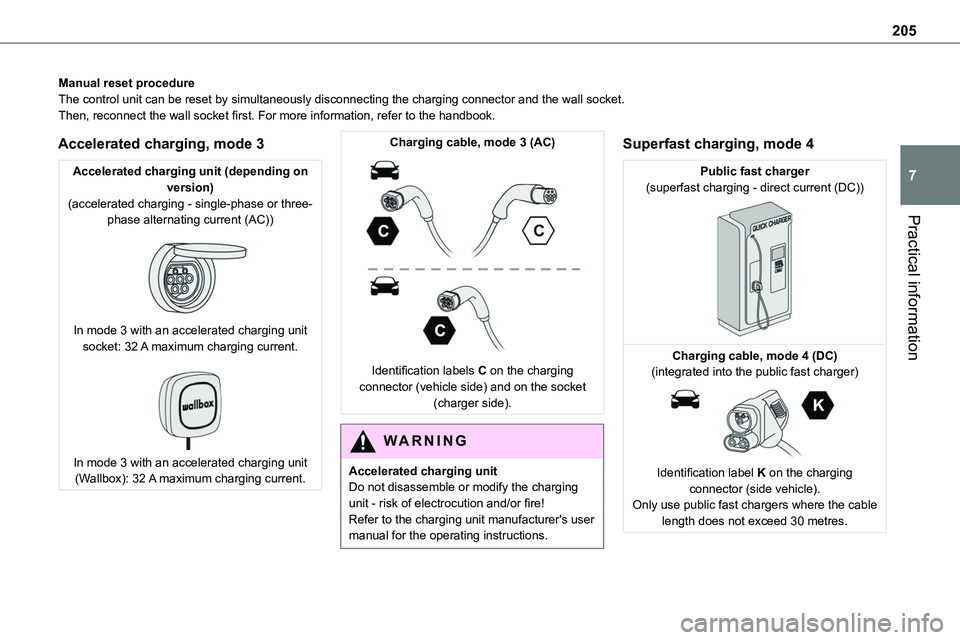
205
Practical information
7
Manual reset procedureThe control unit can be reset by simultaneously disconnecting the chargi\
ng connector and the wall socket.Then, reconnect the wall socket first. For more information, refer to the handbook.
Accelerated charging, mode 3
Accelerated charging unit (depending on version)(accelerated charging - single-phase or three-phase alternating current (AC))
In mode 3 with an accelerated charging unit socket: 32 A maximum charging current.
In mode 3 with an accelerated charging unit (Wallbox): 32 A maximum charging current.
Charging cable, mode 3 (AC)
Identification labels C on the charging connector (vehicle side) and on the socket (charger side).
WARNI NG
Accelerated charging unitDo not disassemble or modify the charging unit - risk of electrocution and/or fire!Refer to the charging unit manufacturer's user
manual for the operating instructions.
Superfast charging, mode 4
Public fast charger(superfast charging - direct current (DC))
Charging cable, mode 4 (DC)(integrated into the public fast charger)
Identification label K on the charging connector (side vehicle).Only use public fast chargers where the cable length does not exceed 30 metres.
Page 254 of 360
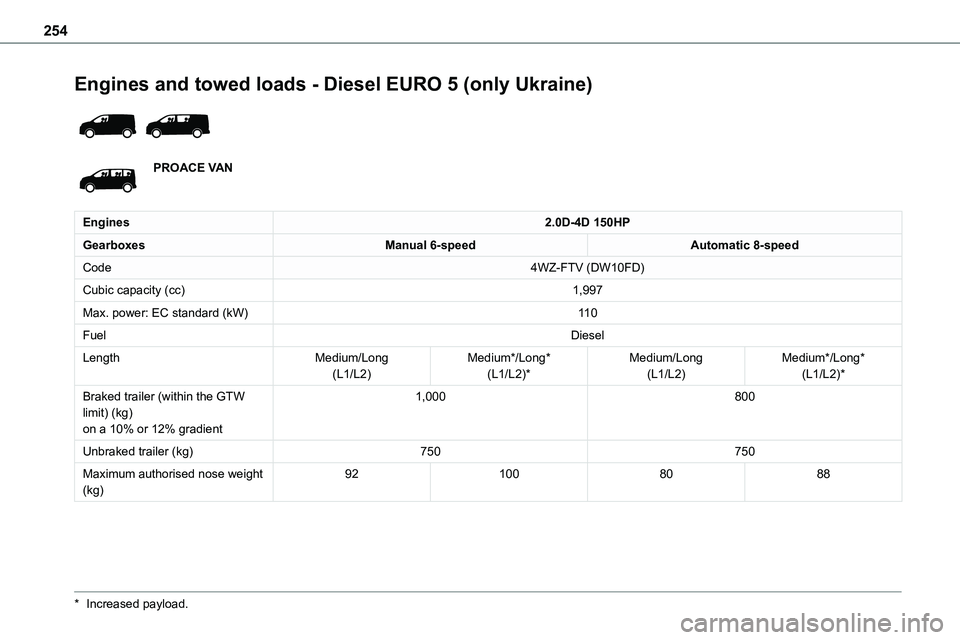
254
Engines and towed loads - Diesel EURO 5 (only Ukraine)
PROACE VAN
Engines2.0D-4D 150HP
GearboxesManual 6-speedAutomatic 8-speed
Code4WZ-FTV (DW10FD)
Cubic capacity (cc)1,997
Max. power: EC standard (kW)11 0
FuelDiesel
LengthMedium/Long(L1/L2)Medium*/Long*(L1/L2)*Medium/Long(L1/L2)Medium*/Long*(L1/L2)*
Braked trailer (within the GTW limit) (kg)on a 10% or 12% gradient
1,000800
Unbraked trailer (kg)750750
Maximum authorised nose weight (kg)921008088
* Increased payload.
Page 255 of 360
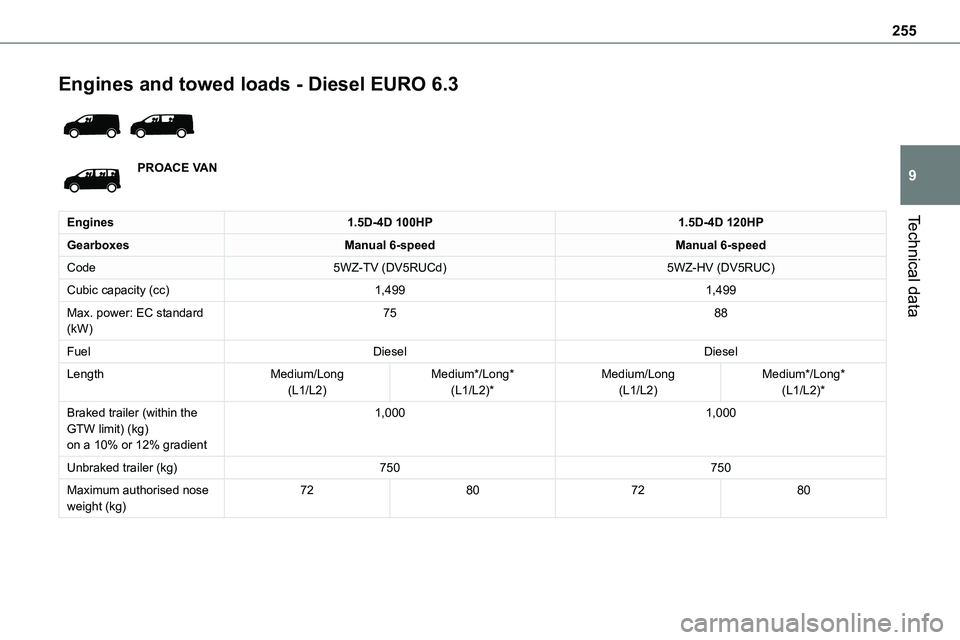
255
Technical data
9
Engines and towed loads - Diesel EURO 6.3
PROACE VAN
Engines1.5D-4D 100HP1.5D-4D 120HP
GearboxesManual 6-speedManual 6-speed
Code5WZ-TV (DV5RUCd)5WZ-HV (DV5RUC)
Cubic capacity (cc)1,4991,499
Max. power: EC standard (kW)7588
FuelDieselDiesel
LengthMedium/Long(L1/L2)Medium*/Long*(L1/L2)* Medium/Long(L1/L2)Medium*/Long*(L1/L2)*
Braked trailer (within the GTW limit) (kg)on a 10% or 12% gradient
1,0001,000
Unbraked trailer (kg)750750
Maximum authorised nose weight (kg)72807280
Page 256 of 360
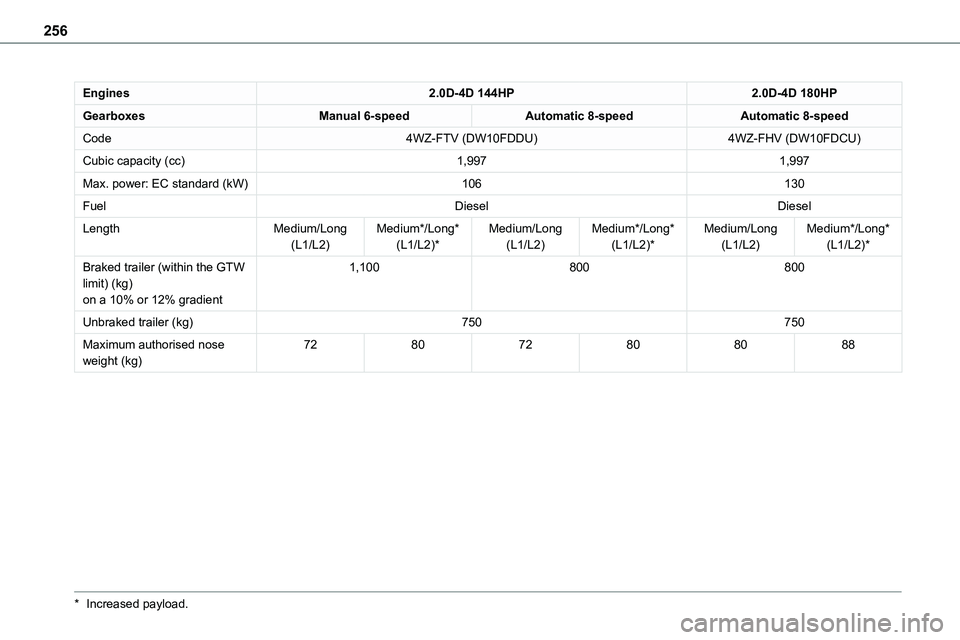
256
Engines2.0D-4D 144HP2.0D-4D 180HP
GearboxesManual 6-speedAutomatic 8-speedAutomatic 8-speed
Code4WZ-FTV (DW10FDDU)4WZ-FHV (DW10FDCU)
Cubic capacity (cc)1,9971,997
Max. power: EC standard (kW)106130
FuelDieselDiesel
LengthMedium/Long(L1/L2)Medium*/Long*(L1/L2)*Medium/Long(L1/L2)Medium*/Long*(L1/L2)*Medium/Long(L1/L2)Medium*/Long*(L1/L2)*
Braked trailer (within the GTW limit) (kg)on a 10% or 12% gradient
1,100800800
Unbraked trailer (kg)750750
Maximum authorised nose weight (kg)728072808088
* Increased payload.
Page 257 of 360
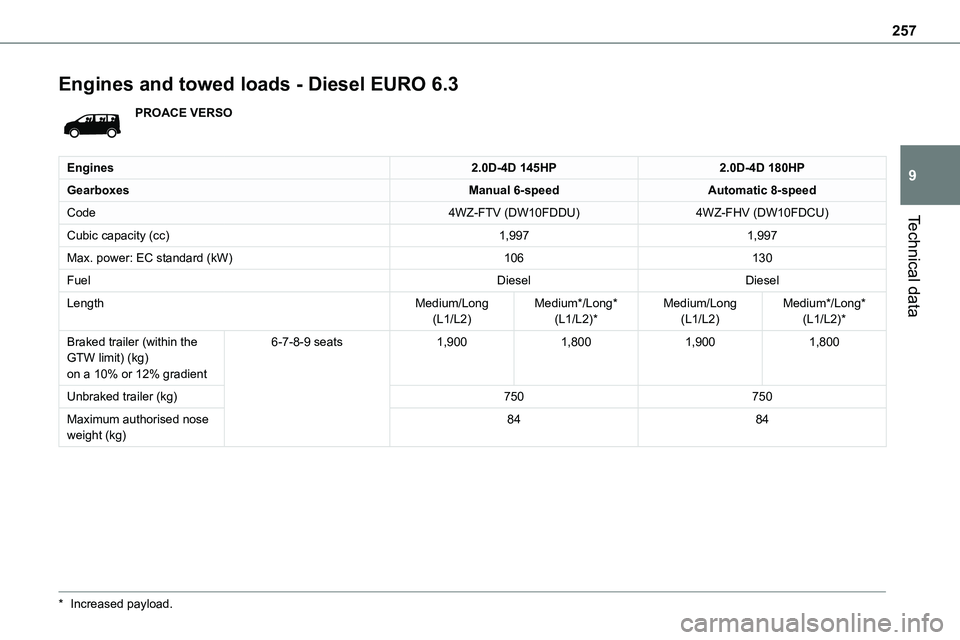
257
Technical data
9
Engines and towed loads - Diesel EURO 6.3
PROACE VERSO
Engines2.0D-4D 145HP2.0D-4D 180HP
GearboxesManual 6-speedAutomatic 8-speed
Code4WZ-FTV (DW10FDDU)4WZ-FHV (DW10FDCU)
Cubic capacity (cc)1,9971,997
Max. power: EC standard (kW)106130
FuelDieselDiesel
LengthMedium/Long(L1/L2)Medium*/Long*(L1/L2)*Medium/Long(L1/L2)Medium*/Long*(L1/L2)*
Braked trailer (within the GTW limit) (kg)on a 10% or 12% gradient
6-7-8-9 seats1,9001,8001,9001,800
Unbraked trailer (kg)750750
Maximum authorised nose
weight (kg)
8484
* Increased payload.
Page 259 of 360
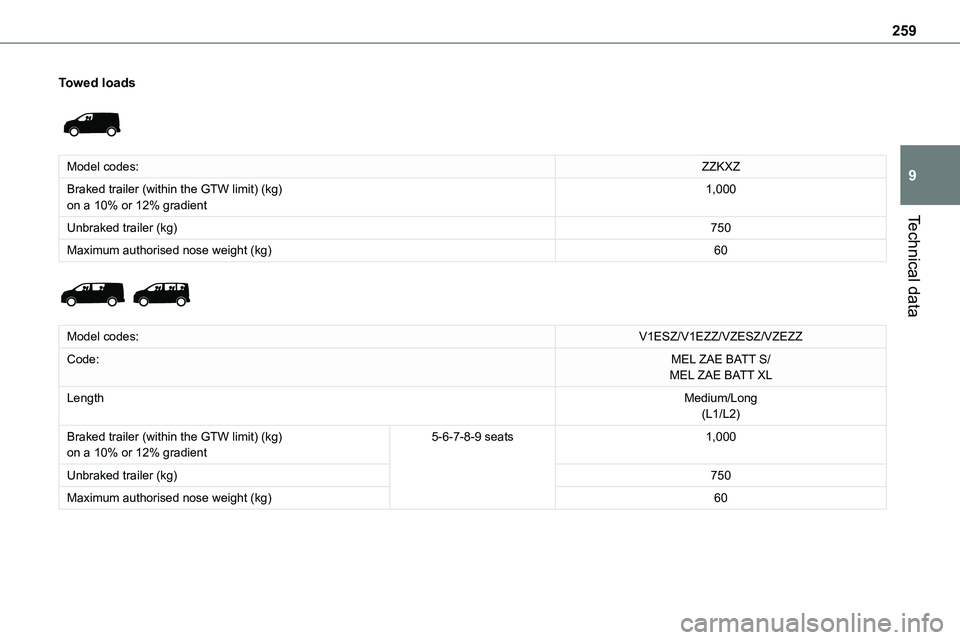
259
Technical data
9
Towed loads
Model codes:ZZKXZ
Braked trailer (within the GTW limit) (kg)on a 10% or 12% gradient1,000
Unbraked trailer (kg)750
Maximum authorised nose weight (kg)60
Model codes:V1ESZ/V1EZZ/VZESZ/VZEZZ
Code:MEL ZAE BATT S/MEL ZAE BATT XL
LengthMedium/Long(L1/L2)
Braked trailer (within the GTW limit) (kg)on a 10% or 12% gradient5-6-7-8-9 seats1,000
Unbraked trailer (kg)750
Maximum authorised nose weight (kg)60